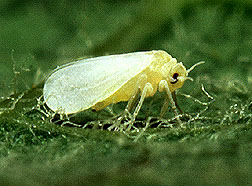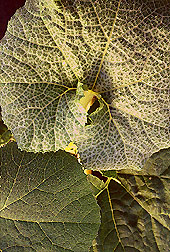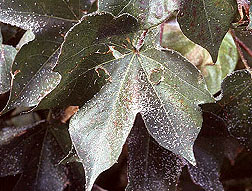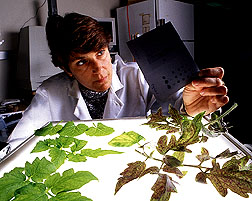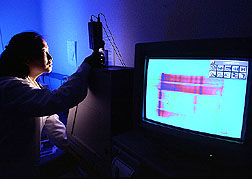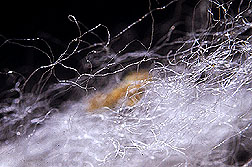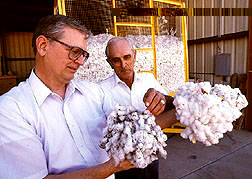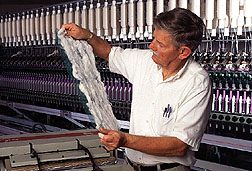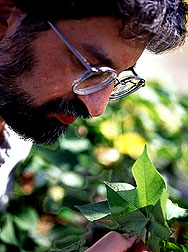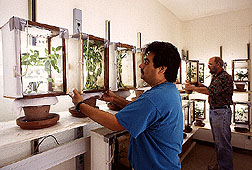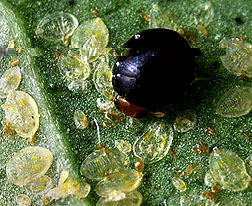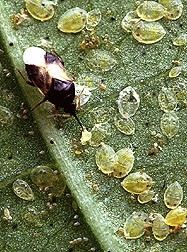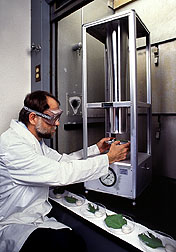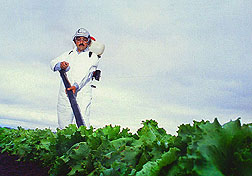The Whitefly Plan: A Five-Year Update
|
|
In 1992, scientists with the U.S. Department of Agriculture, universities, state departments of agriculture, and industry adopted a national 5-year plan of research and action against the silverleaf whitefly, Bemisia argentifolii. This millimeter-long insect, also known as biotype B of sweetpotato whitefly, B. tabaci, has left a multibillion-dollar dent in U.S. agriculture.
What have scientists delivered to help growers?
"Several new technologies are in growers' hands, and a lot of new possibilities have opened up," says Robert M. Faust. He is the Agricultural Research Service's national program leader for field and horticultural crop entomology at Beltsville, Maryland. "Crop and related economic damage have been reduced somewhat," Faust says. "But big challenges remain."
|
|
In the United States, the white sap-sucking insect first appeared on poinsettias in Florida greenhouses in 1986. It spread quickly. Many scientists and growers believed they recognized the culprit as the sweetpotato whitefly, known in this country for a century. But the new pest attacked more crops, reproduced more rapidly, inflicted more damage, and seemed more resistant to insecticides.
By 1990, it had spread to dozens of crops in vital, year-round farming regions of Florida, Texas, California, and Arizona. Losses, roughly $100 to $500 million a year, have probably reached several billion dollars since then.
There isn't room here to summarize all the important contributions of scientists through the research and action plan. But a sampling suggests the scope of their achievements in helping growers get new technology to cope with the pests.
A Spreading Contagion
Along with the new whitefly's appearance in Florida, puzzling and devastating viruses, plant disorders, and diseases began rising. One disorder, tomato irregular ripening, makes the fruit worthless. But since most commercial tomatoes are picked green, the problem often wasn't noticed until buyers discovered the fruit's distorted, incomplete ripening.
Another disorder, not seen before, was marked by silver-colored streaks and blotches on leaves of squash and other plants. Called squash silverleaf, it often affected entire fields.
In early studies, entomologists Raymond Yokomi, Kim Hoelmer, and Lance Osborne proved that only nymphs—an immature stage—of the new pest could produce the symptoms. The adult insect could not. Nor could nymphs or adults of the familiar strain of sweetpotato whitefly.
|
|
"The powerful systemic nature of this and similar disorders has helped stimulate new research on the regulatory mechanisms of plant development," says Yokomi. He is with ARS' Crops Pathology and Genetics Research Unit at Davis, California. At the time, he and Hoelmer were based at ARS' Horticultural Research Laboratory in Orlando, Florida. The studies also confirmed why squash silverleaf is now recognized worldwide as a sign of the new pest.
In 1995, the disorder even lent its name to the new insect. Thomas Perring and Thomas Bellows at the University of California (UC) Riverside identified the pest as a new species, B. argentifolii, and named it "silverleaf whitefly."
But the insect's identity is still in some doubt. Some scientists conclude that it is one of many, perhaps hundreds, of strains of a B. tabaci species complex—and that its important genetic distinctions are only beginning to be revealed. What is clear is that its genetics endow it with capabilities that frustrate growers and scientists alike.
Phantom Infiltrators
Silverleaf whiteflies wreak havoc simply by feeding on leaves and stems. Worse yet, they are prodigious spreaders of plant viruses.
Virus particles wind up in a whitefly's saliva if it feeds on an infected plant. When the insect moves to healthy plants—in the same field or miles away—so does the virus.
Many viruses these insects transmit have not been seen in this country before. At ARS laboratories in Salinas, California, plant pathologists James Duffus and Gail Wisler—along with other ARS colleagues—are unlocking secrets about the viruses and the whiteflies. They'll use the findings to build strategies for protecting crops.
Lettuce chlorosis is among the newly emerging viruses carried by silverleaf whiteflies. It afflicts lettuce and sugarbeets in California and Arizona. Another, tomato chlorosis, attacks Florida tomato crops. These pathogens, known as closteroviruses, typically don't kill plants. But they reduce yield and can ruin quality.
Closteroviruses can escape accurate diagnosis, partly because symptoms of one virus can resemble those of another. Or a virus-infected plant can look identical to one with a different problem, such as a nutrient shortage. To speed accurate detection, Salinas researchers and a team led by Bryce Falk at UC Davis are developing diagnostic tests. When ready, these could be used at labs that scrutinize sickly plants sent by worried growers.
The tests could also help researchers detect virus-infected crops—and weeds that can be viral reservoirs. Gary Simone and Jenny Knight at the University of Florida are trying the Salinas lab's new test for tomato chlorosis. To reveal susceptibility to a different virus, lettuce chlorosis, Rebecca Creamer of UC Riverside has used other diagnostic tests, in collaborative studies with ARS entomologist Steven Castle at Brawley, California.
ARS experiments at Salinas are also determining how long—once it's been picked up by a silverleaf whitefly—a virus remains able to infect other plants. Lettuce chlorosis virus stays active for 4 days in whitefly saliva; tomato chlorosis, only 2 or 3 days. "These basic biological characteristics," says Wisler, "are simple yet important clues for diagnosing the new viruses."
Related work has exposed silverleaf whitefly as a prime culprit in spreading pathogens belonging to another virus family, the geminiviruses. Each geminivirus particle has twin compartments sharing one circular, single-stranded piece of viral DNA.
One geminivirus, tomato mottle, has appeared in every major tomato-producing region of Florida, say Ernest Hiebert and Jane Polston, who are at the University of Florida.
Another, tomato yellow leaf curl, has clobbered tomatoes in the Dominican Republic and Cuba. Hiebert's team and Douglas Maxwell's group at the University of Wisconsin are waging war on this virus. Robert Gilbertson of UC Davis is probing other new geminiviruses in Mexico and South America, as well.
|
|
Judith Brown at the University of Arizona is pursuing geminiviruses of vegetables and cotton in Mexico along with Arizona, Texas, the Caribbean basin, and Central America. She is producing databases with DNA sequences of the pathogens and their whitefly vectors.
"It's all part of trying to know who and where the enemy is," says Brown. She collaborates with the Biological Control Center of USDA's Animal and Plant Health Inspection Service (APHIS) in Mission, Texas; other USDA agencies; and scientists at Texas A&M and other universities.
"Whitefly-transmitted geminiviruses are emerging pathogens with enormous impact in many areas of the world," Brown says. "I've often seen geminivirus spread from a few plants to an entire field within a couple of weeks."
As for her whitefly genetics studies, she says, "A given whitefly population may have an important genetic difference that a parasitic wasp can detect--but human eyes can't. Knowing this difference could help biocontrol workers select the most appropriate parasites for field releases."
Sticking It to Cotton
Whiteflies cost cotton growers money, even after the crop is harvested and trucked to the gin. The insects survive by sucking the sugary sap from plants, and they excrete a sticky waste called honeydew.
Since whitefly densities on leaves may reach thousands per square inch, there are plenty of opportunities for microscopic droplets of honeydew to fall onto open bolls of cotton fibers. The sticky fibers gum up high-speed machinery in cotton gins and textile mills. Processors lose money in down time and cleaning costs. They pay growers much less for sticky cotton, and the problem extends to the export market.
|
|
"The industry uses reliable methods that evaluate several fiber qualities of every bale of cotton produced each year, in a matter of seconds per bale," says Frank Carter, who is with the National Cotton Council in Memphis, Tennessee. "But we don't have such a tool to rapidly measure stickiness of every bale. As a result, we may unintentionally ship sticky bales to our overseas customers. While we work with those processors to minimize their production problems, we have to wonder about customer loyalty."
Next year, growers may be using commercial enzymes to dissolve the stickiness.
The tactic began taking shape a few years ago in Phoenix, Arizona. Plant physiologist Donald Hendrix at ARS' Western Cotton Research Laboratory pinpointed the basic chemistry of more than 30 complex sugars, called oligosaccharides, in whitefly honeydew. He and colleagues searched chemical catalogs for enzymes that might break them down. None worked well.
"Then we obtained one from Genencor International [of Elkhart, Indiana] and were pleased with the results," says Hendrix. "Their chemists suggested another enzyme that turned out even better." It cut stickiness 80 percent in tests at ARS' Cotton Quality Research Station at Clemson, South Carolina.
In field tests, the Arizona researchers experimented with spray nozzles attached to cotton picking machines. But some bolls got too much spray, some too little.
In October, ARS scientists tested a different approach with 15 tons of freshly harvested cotton. They sprayed 1 to 3 pounds of the Genencor enzyme per 1,000 pounds of cotton, using equipment first developed by Wayne Coates of the University of Arizona. Some treatments reduced stickiness 90 to 100 percent.
|
|
In this approach, growers would apply the enzyme before shipping the crop. "This would be fine with most growers. They can wait up to 4 weeks while the enzyme breaks down the saccharides," Hendrix says.
"The enzyme is very effective and—best of all—very environmentally friendly," says O.J. Lantero of Genencor. "It's a protein that poses no threat to workers and can't contaminate soil or water supplies."
After a final analysis this summer by ARS scientists in South Carolina, growers may have guidelines for the 1998 crop, says Tom Henneberry, director of the Phoenix laboratory.
Whitefly Count Tells When To Begin Control
How can a grower know when to strike against the whitefly?
"Growers want to hold off as long as possible," Henneberry says, "so they don't hasten development of insect resistance or waste money on chemicals they don't need. But if they wait too long, the insects may inflict excessive damage."
In cottonfields, "turning leaves over and inspecting for adult insects is the most reliable and cheapest method we have for determining whitefly densities," says entomologist Steven Naranjo at the Phoenix lab.
|
|
The sampling procedure he designed takes only about 10 minutes per field. It's now used in Arizona, California, Texas, and in other countries including Mexico, Israel, Pakistan, and Egypt. ARS researchers tested and implemented it in cooperation with University of Arizona scientists Peter Ellsworth and Jonathan Diehl.
Sampling methods and thresholds are still needed for other crops, Henneberry notes.
Getting Around Resistance
"When only one or a few insecticides are used over time, some insects may prove to be unaffected," says David Akey, ARS entomologist at Phoenix. "It takes only a few resistant whitefly pairs out of millions of susceptible ones to negate years of research development." Silverleaf whiteflies have this capability to an unusual degree, partly because they can produce a new generation about every 3 weeks.
But Nick Toscano and Nilima Prabhaker Castle of the University of California, Riverside, and ARS' Steve Castle lead a project that is helping growers delay this resistance.
For the project, yellow sticky cards are sprayed with one or a combination of insecticides growers use. Knowing how many whiteflies are killed by each treatment lets scientists monitor changes in chemical resistance over time. They conduct the monitoring biweekly in three California valleys—Imperial, Palo Verde, and San Joaquin—and report the mortality data via newsletters, news media, and the Internet.
As a result, growers and pest control advisers can quickly respond with more effective strategies. This includes avoiding spraying the same insecticide more than twice consecutively and, instead, rotating to a different insecticide class—for example, from a pyrethroid to an insect growth regulator.
In 1996, Imperial County adopted a new trap for whitefly monitoring. Chang-Chi Chu of ARS' Phoenix lab developed and tested it in cooperation with ARS colleagues Henneberry and Allen Cohen and Kai Umeda of the University of Arizona. ARS is planning to patent the technology.
The new trap allows more accurate population estimates, largely because it doesn't get overloaded with massive numbers of whiteflies and traps only the adults. And since it isn't sticky, it can be reused, so it's more economical.
Today's Options
Breeding is a traditional tool for reducing crop loss from pests. Scientists have identified varieties or lines of cotton, alfalfa, tomato, soybean, and other crops on which whiteflies inflict less damage. But it takes years for improved breeding lines to reach growers as commercial varieties.
|
|
Alfalfa lines with some whitefly resistance have been developed by Larry Teuber at UC Davis. Imperial Valley growers are helping fund the alfalfa studies at UC's Desert Research and Extension Center in Holtville.
The earliest cotton harvested in the United States for the past 2 years was a new commercial variety that offers some whitefly protection. The Texas 121 variety is derived from lines developed by Charles Cook at ARS' Subtropical Agricultural Research Laboratory in Weslaco, Texas. The plants mature earlier, so they escape some of the whitefly's late-season buildup in south Texas.
Organophosphates and pyrethroids remain common chemical choices of growers battling whiteflies. But alliances among growers, scientists, and industry have widened the options. For example, a federal-state-industry team cooperated to seek an emergency exemption from the U.S. Environmental Protection Agency (EPA) allowing use of two insect growth regulators, or IGR's, on Arizona cotton in 1996. [More on IGR's in "Forum" article: click here.]
Whitefly researchers have focused mainly on natural or nature-based controls, including quite a number of fungi, insects, and plant compounds.
Wasps: Sting Operations at Home and Abroad
ARS' European Biological Control Laboratory in Montpellier, France, has been the primary source of whitefly natural enemies imported from abroad. From 1992 to 1996, Montpellier entomologist Alan Kirk and insect pathologist Lawrence Lacey (now with ARS' Yakima Agricultural Research Laboratory in Wapato, Washington) explored 25 countries in Africa, Asia, Europe, and South America. They sent U.S. colleagues over 100 shipments of more than 30 species of parasitic and predatory insects and hundreds of isolates of whitefly-killing fungi.
Nearly all the insect shipments went first to APHIS' Biological Control Center in Mission, Texas.
Since 1993, the APHIS workers have reared 46 species or populations of exotic whitefly parasites and predators. The center has distributed over 28 million beneficial insects to dozens of scientists for lab and field studies.
|
|
Among the shipments to Mission was a parasitic wasp Kirk and Lacey found in Spain. The female Eretmocerus wasp deposits an egg under a whitefly larva. The egg hatches, and the immature wasp feeds on the whitefly, killing it. Eventually the wasp emerges as an adult and seeks a mate.
In studies, John Goolsby, Matt Ciompernik, Lloyd Wendel, and Don Vacek of the Mission center and ARS entomologist Walker Jones at Weslaco compared the Spanish wasp with other exotic and native wasps. The Spanish Eretmocerus attacked more whiteflies on cantaloupe, kale, and broccoli than did other parasitic wasps. It was also more tolerant of some pesticides. Jones says this increases this wasp's potential for situations when insecticide must be used against other pests.
In 1995, ARS scientist Kirk, Jesusa Legaspi, who is with Texas A&M University's Research and Extension Center, and Ray Carruthers (now ARS national program leader for biological control) collected wasps, fungi, and ladybugs in Thailand, Taiwan, Malaysia, and Indonesia. At Mission, an ARS-APHIS team evaluated many strains of exotic beneficials on cotton, melons, and broccoli to determine which strains produced the highest attack rates on each plant type. APHIS is using the results to plan mass-rearing for field releases.
Exotic Eretmocerus species and strains have been released in many field trials. APHIS and the UC's Cooperative Extension conducted trials in spring melon fields in the Imperial Valley. Early-season releases would be a feasible tool for growers if the wasps become available through commercial insectaries, says Gregory Simmons of APHIS.
Descendants of Eretmocerus from Spain, India, and Pakistan have persisted 1 or 2 years after releases near Bakersfield in the San Joaquin Valley. Charles Pickett of the California Department of Food and Agriculture and APHIS' John Goolsby and William Abel released the wasps.
With all these wasps to pick from, how can growers know what is the best six-legged tool for the job in a particular crop?
Hoelmer and Simmons of APHIS found preliminary answers in studies in California and Arizona. They identified strains of exotic Eretmocerus and Encarsia wasps that were most prolific in cantaloupe, broccoli, and alfalfa crops. Mass-rearing and release of standout wasps for field trials is under way. Wasps that pass muster could join growers' anti-whitefly arsenal.
|
|
One complication: Some exotic wasps are very closely related to—and look almost identical to—some native wasps.
"Right now, the only way to know which biocontrol wasp agent is present is to dissect individual whiteflies and examine each parasite under a microscope," says ARS entomologist Bruce C. Campbell at ARS' Western Regional Research Center in Albany, California.
Campbell has identified genetic regions that can distinguish among closely related wasps. He's working on a field test—a few years away—that would let scientists quickly check many whiteflies for the presence and abundance of specific parasites.
Oscar Minkenberg of the University of Arizona showed a native Eretmocerusfrom Arizona to be valuable in greenhouses. Based on his early results, some growers began using the wasp in 1993, especially in Europe, where greenhouse vegetable farming is more common than in this country.
Late in 1995, some of Minkenberg's research funding came from Beneficial Insectary of Oak Run, California.
"We don't plan to rear this wasp ourselves, because the U.S. market is not yet big enough to justify it," says Sinthya Penn, the firm's president. "But at the time, there was no other consistent supply. We just wanted to be sure the wasp was available so the research could be completed."
Now, three insectaries in Europe are mass-rearing the insect and selling it there and in the United States.
Predators: Whiteflies on the Menu
Even before imported wasps found U.S. homes, researchers were examining a different breed of biocontrol: native predators such as Delphastusbeetles.
|
|
In Florida in the late 1980's, Hoelmer, Osborne, and Yokomi conducted studies of Delphastus that led to its commercial development. It is available from insectaries worldwide, primarily to protect greenhouse crops. Its use is compatible with parasitic wasps and commercial products made with oil from seed of the neem tree, Hoelmer says.
In Phoenix, meanwhile, ARS entomologist James Hagler is biochemically pumping the stomachs of native predators to find out what they eat. He has developed several quick tests called predator gut content immunoassays. Each assay uses a custom-built molecule that binds only to a specific protein—in one case, a protein in whitefly eggs. So it reveals whether the predator recently had a meal of whitefly eggs.
The same technology is used in home pregnancy test kits and other medical applications. Hagler and colleagues are first to field-test this approach for insect predators. Other researchers have adopted it, and APHIS experts are exploring using it to screen predators of whiteflies and other insect targets.
Studies by Hagler and Naranjo turned up a surprise: the native collops beetle, Collops vittatus. Not readily abundant in cottonfields, it's been overlooked as a potential biocontrol. But almost two-thirds of the beetles tested positive for whitefly eggs.
A predator from India also shows a hearty appetite for whitefly eggs. In an ARS lab test at Weslaco, immature Serangium parcesetosum beetles all but ignored eggs of corn earworm and tobacco hornworm. They chowed down whiteflies instead. Each beetle ate about 600 whitefly eggs and nymphs in 24 hours, according to Texas A&M's Jesusa and Benjamin Legaspi.
Helpful Fungi
In March 1995, the EPA approved commercial use of Mycotrol, a product made with a whitefly-killing fungus, Beauveria bassiana. The product grew from a cooperative research and development agreement (CRADA) between ARS and Mycotech Corp. of Butte, Montana.
Mycotrol-WP is a powder containing the fungus. Farmers spray it in a mix with water and a wetting agent. The fungi invade the whitefly and destroy its insides.
|
|
In Weslaco, ARS entomologist Ray Carruthers and Stephen Wraight, then with Mycotech, conducted lab trials that identified the B. bassiana strain as a candidate for commercialization. In 1994, this Mycotrol strain killed up to 90 percent of immature whiteflies in small vegetable plots. EPA's registration opened the way to large-scale tests by Mycotech, ARS, APHIS, land-grant universities, and growers. A Mycotech factory that can produce enough fungus to treat 500,000 acres a year was scheduled to go on line last month.
Strains of another fungus, Paecilomyces fumosoroseus, also perform well against whiteflies. Developing a more economical mass-production technique for it is the goal of another CRADA with Mycotech, in studies led by ARS researchers at Weslaco and ARS' National Center for Agricultural Utilization Research in Peoria, Illinois. The new technique uses liquid fermentation, in which Paecilomyces forms yeastlike cells called blastospores.
Lacey, Kirk, and David Akey of ARS experimented with using mist irrigation to apply blastospores of U.S. strains of Paecilomyces in greenhouses. The fungi killed up to 80 percent of whiteflies on heavily infested tomato and cucumber plants.
In experiments at the University of Florida, entomologist Lance Osborne discovered that a native strain of P. fumosoroseus is highly effective at killing whiteflies and also kills spider mites, aphids, and diamondback moths. Under a license from the university, Thermo Trilogy Corp. of Columbia, Maryland, incorporated this fungus into a commercial product. It will soon be sold in Europe to control whiteflies and other pests in greenhouses. Thermo Trilogy has applied to EPA to register the fungus for use in the United States.
Fungal Complications
Can fungi that kill whiteflies also kill helpful insects? Unfortunately, they may. To assess the extent of possible damage to beneficials, insect pathologist Tad Poprawski of Texas A&M University and ARS entomologist Walker Jones ran cooperative studies at Weslaco with APHIS' Mission facility. The scientists examined effects of Paecilomyces and Beauveria on more than two dozen beneficial insects. Results suggest an acceptable level of compatibility exists between the fungi and most beneficials.
|
|
One promising duo is Beauveria and an Eretmocerus wasp native to south Texas. The researchers' findings suggest that spraying Beauveria on crops a few days after releasing wasps could increase total whitefly mortality, because the fungus would kill many whiteflies that escaped the wasps. Earlier, the scientists found that the fungus doesn't invade a whitefly already doomed by a developing wasp parasite. So a parasite can safely develop to adulthood and emerge to seek a mate, spelling more trouble for more whiteflies.
In another cooperative study with APHIS, Poprawski and Wraight controlled whiteflies in a year-round rotation of broccoli, fall cucumbers, spring cantaloupes, and cotton. They used Beauveria, parasitic and predatory insects, and (on the melons) one early-season application of the insecticide imidicloprid. With this approach, crops wouldn't need several costly sprays of pyrethroids late in the season, say the scientists.
Scientists also want to learn if beneficial fungi can be harmed by chemicals used to suppress crop-damaging fungi. In tests on cantaloupe plots, Poprawski and Wraight found strong clues to which fungicides can be used—and when—with Beauveria.
Chemical Defense Plants
Under a CRADA, ARS evaluated a mixture that Morse Enterprises Limited, Inc., of Miami, Florida, designed to boost tomato yield. Besides nutrients, the mix contains alpha keto acids. A plant can use these acids more readily than the amino acids from which they are made.
"We had found that the mix also boosted plants' natural defenses," says Richard Mayer, director of ARS' Horticultural Research Laboratory in Orlando, Florida.
Plants make defense proteins and chemicals when being fed on by whiteflies, but their normal response is slow and weak. In tests, Mayer and colleagues sprayed the mixture on tomato plants. They then recommended improvements to the mixture's formula to further boost the defense substances.
|
|
Morse plans to market the mixture in 1997 under the KeyPlex product line. In other studies, Mayer, biochemist Hamed Doostdar, and entomologist Moshe Inbar are following clues that silverleaf whiteflies may manipulate a plant's chemical defenses for their own benefit.
An extract from neem tree seed oil is the key ingredient in three new biopesticides—Trilogy, Triact, and Rose Defense—developed under a CRADA between ARS and Thermo Trilogy Corp.
In ARS studies at Beltsville led by James Locke, neem seed oil killed whiteflies and other pests. The oil also protects plants against some fungal diseases, including powdery mildew and black spot, says Locke. He is in the Floral and Nursery Plants Research Unit of the U.S. National Arboretum.
Other plant defenses with antiwhitefly potential include extracts of leaves of Nicotiana gossei, a wild Australian relative of tobacco. Leaves of the plant turn out sucrose esters--sugar molecules with attached fatty acids—that kill pests. The extracts killed whiteflies, aphids, pear psyllas, and other insects in tests at the Floral and Nursery Plants Research Unit and other locations.
Industry is also looking at synthetic sucrose esters. These were developed by chemist O.T. Chortyk (retired) at ARS' Richard B. Russell Agricultural Research Center in Athens, Georgia. Firms testing synthetic esters against whiteflies or other pests include Rohm and Haas Co. of Spring House, Pennsylvania; Fuller System, Inc., of Woburn, Massachusetts; and Griffin Corp. of Valdosta, Georgia.
"All these developments are encouraging, and we may have turned the corner on this pest," says national program leader Faust. "But we are far from finished. We need to strengthen our collaboration with growers and industry so more scientific knowledge and effective strategies can be put in place." -- By Jim De Quattro, Dennis Senft, and Marcia Wood, ARS Information Staff.







